 Brew coffee.
Brew coffee.1 Eat.
You’ve probably been so busy and excited that you didn’t have a chance to eat at the reception. Have some food now.
2 Postpone physical contact.
Unwind from the stress and excitement of the wedding before heading to the bedroom. Do something you both enjoy: Get an ice cream, take a stroll in a park, or just sit in a quiet place and talk about the day.
3 Eat mood-enhancing food.
Chocolate is an excellent mood enhancer: It contains the stimulants caffeine, theobromine, and phenylethylamine, as well as anandamide, a chemical—also produced naturally by the brain—that may enhance feelings of well-being.
4 Get the room ready.
Dim the lights, adjust the temperature, light scented candles, and put on soft music. Keep juices, bottled water, and fresh fruit on hand to rehydrate, rejuve-nate, and reinvigorate.
The bride and groom should be relaxed, comfortable, and confident. Offer a foot rub. Use lavender soap and scent to promote relaxation. Put on a cozy nightgown or robe over sexy lingerie or underwear.
6 Do something you’ve never done before.
 Brew coffee.
Brew coffee.
Pass a mug of coffee repeatedly under your spouse’s nose.
 Begin undressing your spouse.
Begin undressing your spouse.
Remove his socks to cool his body, then follow with his shirt, pants, and underwear. Most people will wake up if they sense they are being undressed.
 Rub ice cubes over your spouse’s body.
Rub ice cubes over your spouse’s body.
Start with the forehead, wrists, and soles of the feet. Keep going.
 Apply pressure to the nail bed.
Apply pressure to the nail bed.
Take the tip of one of your spouse’s fingers and hold it between your thumb and index finger. Very gently, apply steady pressure to the nail bed. Do not squeeze too hard. This method, used by emergency personnel to determine unconsciousness/unresponsiveness in victims, causes sharp pain. It should revive your partner quickly.
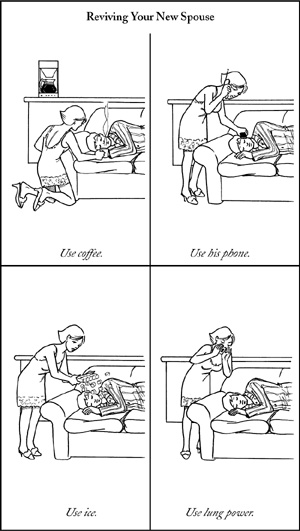
 Call on the telephone.
Call on the telephone.
If you are in a hotel, call the front desk and ask them to ring your room. Or call your spouse’s mobile phone from your mobile. Most people will respond to the sound of a ringing phone.
 Pretend there is an emergency.
Pretend there is an emergency.
Yell “Fire!” “Earthquake!” “Muggers!” and “Watch out!” repeatedly to get your spouse’s adrenaline flowing. Once your spouse is awake, you can explain that you weren’t ready for your special night together to end.
1 Expose damaged skin to air.
Remove all clothing around the burn area: Clothing will irritate the burn site and may cause increased pain.
2 Drink water.
Drink at least 32 ounces of water to help promote sweating, which cools the skin.
3 Apply a cold compress.
Put ice in a plastic bag, wrap in a cotton T-shirt or other fabric, and apply to the burn area. If the burn area is very large, soak a bed sheet in ice water and apply it instead of a compress. Let the skin cool under the compress for 15 minutes to help reduce pain.
4 Apply a soothing gel or ointment to the burn area.
Carefully rub a cooling aloe lotion into the burned area. This is especially soothing if the aloe has been chilled in a refrigerator or a bucket of ice. Do not apply suntan lotion, baby oil, petroleum jelly, or any other foreign substance to the burn.
Ibuprofen will help reduce pain at the burn site.
6 Lie still.
Lie in a position that best exposes your sunburn to the air without coming into contact with the bed, your clothing, or another person. Do not bend sunburned joints.
7 Continue with your honeymoon.
Take advantage of loose-fitting island fashions as your sunburn heals.
Be Aware
Depending on the severity of the sunburn, a new layer of skin will replace the burned area in two days to two weeks.
1 Dim the lights.
Bright lights may exacerbate a migraine or prolong symptoms. Keep the shades drawn and the room lights off or very low.
2 Reduce noise levels.
Turn off the radio and television. The room should be silent, or with soothing “white” noise such as that created by a small fan.
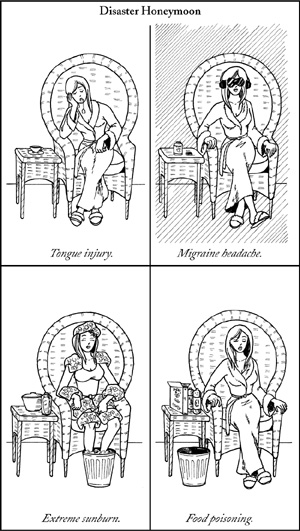
Running, walking, and even climbing stairs may increase the intensity of a migraine.
4 Eat vitamin-rich foods.
Magnesium and vitamin B2 (riboflavin) may combat migraine symptoms. Spinach, Swiss chard, and many nuts are high in magnesium, while mackerel, shad, and other oily fish are rich in riboflavin.
Be Aware
A migraine may last as little as one hour or as long as three days.
1 Prepare a tea bag.
Soak a tea bag in warm water for 2 minutes. Let it stand 1 minute at room temperature, then wrap it in gauze or a clean cloth napkin.
2 Apply tea bag to tongue.
Place the moist tea bag on the injury site and press steadily. The tannic acid in the tea is a natural coagulant and should stop the bleeding. The tongue has a large number of blood vessels near the surface and will bleed profusely until the blood coagulates.
3 Rinse.
Swish and spit using an anesthetic mouthwash, if available.
Apply ice to the wound to numb and reduce pain.
5 Avoid acidic and salty foods and liquids.
Acidic substances, such as citrus fruits and vinegar, and those high in salt, such as nuts and potato chips, may aggravate the injury.
6 Keep the tongue still.
The tongue will heal more quickly if it is inactive.
7 Protect the tongue.
Wear an athletic mouth guard to protect the tongue until the injury heals.
1 Stay hydrated.
Drink several gallons of water a day.
2 Replenish mineral salts.
Nibble on dry salted crackers or plain rice to replace salt lost through diarrhea.
3 Do not induce vomiting.
Vomiting will not remove the bacterial culprit, but will cause dehydration.
• Do not drink the water when traveling to the tropics or when you are unsure of its cleanliness. Avoid ice cubes in drinks, brushing your teeth with tap water, opening your mouth in the shower, or swallowing—or even rinsing your mouth with—water in swimming pools or the ocean.
• Only eat fruit that you can peel yourself. Avoid all vegetables and fruits that could have been washed in contaminated water, or fruits (like melons) that might have been soaked in water to increase their size and weight.
• If you don’t know what it is, don’t eat it.
 Order an emergency bouquet.
Order an emergency bouquet.
Many florists can assemble arrangements with little notice. If you have just minutes to prepare, scour your neighborhood flowerbeds for daisies. Wrap them in colorful ribbon and present them as your initial gift.
 Buy chocolates.
Buy chocolates.
Most supermarkets and drugstores carry chocolate assortments. Choose a tasteful boxed set rather than several loose candy bars tied with ribbon.
 Create a voucher card.
Create a voucher card.
Prepare a card or piece of paper that shows the wonderful gift you’re giving but can’t give now because it isn’t ready yet. Draw a picture of the gift on the card or paper.
 Apologize, apologize, apologize.
Apologize, apologize, apologize.
If you’re caught with nothing, making excuses will not help your case. Your level of contrition should be so extreme that your spouse begins to feel bad because you feel so terrible.
Give her a homemade certificate for a weekend spa getaway. It could be for her only, or for a romantic weekend for both of you—a “second honeymoon” (but don’t push your luck). A week free of household chores, a weekend of breakfasts in bed, or getting her car detailed are other possibilities.
1 Remove the back cushions.
If the couch has loose back cushions, take them off to add more width to the sleeping surface.
2 Remove the arm cushions.
Side cushions take up precious head and leg room, and will just end up on the floor in the middle of the night anyway.
3 Fluff and flip.
If the sofa design permits, remove the seat cushions, fluff them, then flip them so the side that was down is now the top. This will provide a more even sleeping surface.
4 Cover the seat cushions with a sheet.
The sheet will protect your face from odors trapped in the cushions and will protect the seating area from saliva.

You will sleep better with your head resting on a familiar pillow. Get yours from the bedroom, if the bedroom is still accessible to you.
6 Depending on the temperature of the room and your comfort level, get a sheet, blanket, comforter, or large towel to put on top of you.
7 Relax.
Do not to go to bed angry.
Be Aware
If you are an active sleeper, lay the sofa cushions next to the sofa to break your fall should you roll off during the night.
 Swaddle the baby.
Swaddle the baby.
Fold down one corner of a receiving blanket and place the baby on top of the blanket with his head above the fold. Pull one side of the blanket securely across the baby’s chest and tuck it underneath his body. Then pull up the bottom, folding the edge back, and finish by pulling the remaining side of the blanket across the baby’s chest and underneath the body. The baby should fit snugly inside the blanket.
 Sway.
Sway.
Hold the swaddled baby close to your chest. Shift your weight from one foot to the other. This rhythmic stimulation will induce a sleepy state in the baby. Position the child so that his ear is over your heart. The beating will soothe him.
 Generate soothing white noise near the baby.
Generate soothing white noise near the baby.
Sound produced by a clothes dryer, dishwasher, blender, coffee grinder, hair dryer, vacuum cleaner, lawn mower, leaf blower, or air conditioner has a lulling potency that many babies cannot resist. Metronomes and ticking clocks can also soothe a baby to sleep by reminding a child of his mother’s heart beat.
 Put the baby on a washing machine or dryer.
Put the baby on a washing machine or dryer.
Turn on the machine and set to normal cycle. The vibrations and noise are sleep-inducing. Do not leave the baby unattended.
 Go for a drive.
Go for a drive.
The steady vibration of the car will have most infants asleep quickly. Open the window a crack and the air will keep you awake while the sound of the wind functions as soothing white noise for the baby. Do not get behind the wheel if you are exhausted and cannot operate heavy machinery.
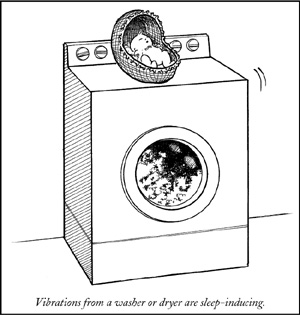
 Dance to music with a strong beat.
Dance to music with a strong beat.
Hold the child securely in your arms and bounce, twirl, and dip in a rhythmic fashion. Concentrate on moving the baby to the beat. The nonstop, steady jiggling will overload the brain’s processing center. Avoid atonal, early-twentieth-century classical music, bebop, or any other music that could be jarring. Better choices include reggae, house, dance/trance, disco, minimalist, and pop.
 Climb up and down a staircase.
Climb up and down a staircase.
Make sure your grip is tight around the baby. Go up and down at a rapid, steady pace.
 Use a pacifier.
Use a pacifier.
A pacifier (also known as a binky, paci, dummy, comforter, fooler, ninny, soother, soothie, or yum yum) can be an extraordinarily potent sleep inducer for some babies, but it can be habit-forming, and may cause problems if lost or stolen.
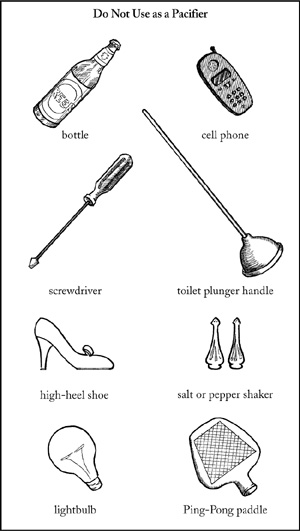
1 Crawl around on your hands and knees to see the house from your child’s point of view.
Anticipate the things that will interest him.
2 Remove all sharp edges.
Create corner bumpers out of foam or bubble wrap. Protect all hard edges within the child’s reach, including coffee tables, end tables, bookcases, televisions, entertainment centers, hard chairs, dressers, bed stands, and desks.
3 Protect electrical outlets.
Use spring-loaded release covers in electrical outlets; plastic slip-in outlet guards can be too easily removed. Alternatively, move electrical outlets higher on the wall, to just below the ceiling, or replace all electrical appliances with battery-operated appliances. Batteries are toxic, however.
4 Install window guards.
Use window guards that prevent windows from opening more than 4 inches. Use the sliding button guard or the lock-and-key guard (which also keeps burglars out, but might prohibit a fast exit in an emergency). Protect low-to-the-ground windows with a hard plastic sheet or soft Mylar coating that prevents a child from shattering the glass. Do not use tilt-out windows unless windows are kept closed and locked at all times. Alternatively, install bars not more than 2⅜ inches apart on the outside of windows.

5 Install childproof doorknob spinners.
Deter your child from entering unsafe rooms or closets by covering all doorknobs with childproof covers that will spin loosely when a child attempts to turn the knob.
6 Install drawer and cabinet guards.
To prevent your child from reaching knives in a drawer or cleaning agents under the sink, secure drawers and cabinets with childproof latches.
7 Hang towels over the top of doors to prevent the child from slamming the door on his fingers.
Alternatively, remove all doors.
8 Bolt heavy furniture to walls.
Tall, heavy furniture can be tipped and pulled down by children, especially if they are climbing. Strap or secure bookcases, dressers, cabinets, and televisions. Tape lamps to tables or floors.
9 Avoid entanglements.
Tie up (or down) or remove all curtains, blinds, and cords, especially electrical cords.
10 Remove poisonous plants.
If you are not sure which plants are poisonous, throw them all away. Eliminate hazardous outdoor plants as well as houseplants.
Use gates that are 30 inches tall and have only vertical posts, with a bar top and bottom: Do not use diamond-shaped accordion gates that a child can climb. Place a gate at the top and bottom of a staircase. Keep gates closed at all times, even when the baby is asleep or not home.
12 Block the fireplace.
Put a nontoxic plant or fake logs in the grate. Install a gate around the outside of the hearth to prevent the child from approaching the fireplace or from sustaining an injury after hitting the edge of the fireplace. Put away all fireplace tools. Do not use the fireplace for actual fires until the child is older.
13 Reduce the temperature of the hot water heater.
Turn the water heater to 120°F or below to prevent scalding.
14 Install a spout guard over the bathtub spigot.
Mount foam on the metal faucet to prevent inadvertent head gouging or bumping while bathing.
15 Install a stove guard.
Attach a plastic shield in front of your stove’s burners to prevent your child from reaching up and over-turning pots and pans or burning fingers on hot or flaming surfaces. Affix knob protectors so your child cannot accidentally turn on the range.

16 Put lid guards on all toilets.
Do not let the baby watch a dog drink from the toilet bowl.
17 Line floors with gym mats.
Cover all flat surfaces with gym mats several inches thick to provide extra padding in case of a fall.
Be Aware
Keep purses and diaper bags, which are repositories for dangerous items and choking hazards, out of the reach of children. Put away guests’ bags as well.
1 Wear cargo pants.
Fill the pockets with soft items:
• Burp cloth
• Bibs
• Change of clothes (for you and for baby)
2 Dress the baby in cargo pants.
Fill the pockets with small necessities:
• Baby’s cap
• Small board book for entertainment
• Teething ring
3 Wear a photographer’s or fisherman’s vest.
Fill the pockets with necessities:
• Small camera and film
• Baby blanket
• Crib toy
• Baby manual
• Hand sanitizer
• Bowl and spoon
• Changing pad
• Shampoo
• Nail clippers
• Bath soap
• Fever-reducing medicine
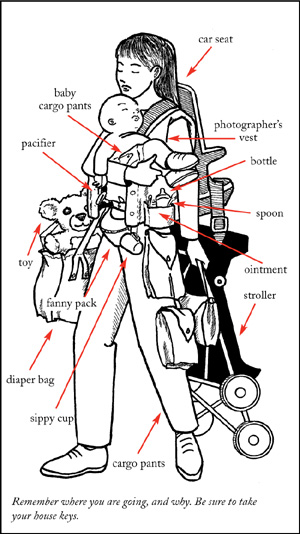
• Anti-itch cream
• Saline drops
• Nasal bulb syringe
• Thermometer
• Tissues
• Meat tenderizer for bee stings
• Adhesive bandages
• Antibiotic ointment
• Toothbrush and paste
• Plastic bag for soiled diapers
• Plastic bag for wet/dirty clothes
4 Wear a fanny pack.
Fill with adult necessities:
• Keys
• Wallet
• Headache medicine
• Sunglasses
• Makeup
• Cell phone
• Shopping list
• Pen
5 Circle your waist with a web belt.
Attach a canteen (for you) and a bottle or sippy cup (for baby).
6 Clip a pacifier to the baby.
7 Sling a messenger bag across your back.
Fill with remaining necessities:
• Umbrella
• Toys
• Diapers
• Diaper wipes
• Cotton balls
• Sunscreen
• Diaper cream
• Juice
• Crackers
• Video camera
8 Wear a baby carrier or sling.
Place the baby in the carrier and go. Remember where you are going, and why, and be sure to take your house keys with you.
1 Maintain visual contact with your baby.
Observe her medical condition. Trick your baby into thinking that you meant to create this situation. See “How to Keep Your Baby Calm” on the following page.
2 Try a key from a similar model of car.
Ask passersby if they drive the same type of car. Ask if they will try to open your door with their key.
3 Use a coat hanger to break in.
Bend a wire hanger into a long J. Square off the bottom of the J so that the square is about two inches wide. Slide the hanger into the door, between the window and the weather stripping. Feel for the end of the button rod and, when you have it, pull it up to open the lock.
4 Break the window.
Don a pair of gloves, mittens, or socks to protect your hands from abrasion and injury. Select the window farthest from your child—a front window is ideal. Use a sharp object to punch through the middle of the window—try a rock, hammer, crowbar, piece of concrete from a broken curb, or even a concrete parking spot marker. Hit the window with enough force to break the surface tension on the glass. Do not use your fist or a blunt object, neither of which will break the glass.
5 Call for help.
Police officers and firefighters sometimes carry keys or lock-pick tools, or call a locksmith. A professional can often spring the lock in as little as three seconds with no damage to your car.
Be Aware
• In cold weather, do not warm up the car with the child inside. Many new cars automatically lock the doors once the ignition is turned on.
• Larger glass panels are less expensive to replace than fixed panels, such as small quarter panels.
 Pretend to be calm yourself.
Pretend to be calm yourself.
The baby will feed off of your fear if you reveal it.
 Play peek-a-boo.
Play peek-a-boo.
Begin with the standard hands-in-front-of-face style, then try hiding your face with a scarf or hat, and finally pop up from below various windows.
 Enlist the help of passersby.
Enlist the help of passersby.
Select friendly-looking people and people with babies who can coo at your baby through the window. Keep your child entertained and happy.
 Hoist a small dog in front of a window.
Hoist a small dog in front of a window.
Turn the dog around to show its funny wagging tail.
 Hold up a magazine.
Hold up a magazine.
Turn the pages in front of the window so baby can see bright images.
 Use makeup to color yourself like a clown.
Use makeup to color yourself like a clown.
Smear lipstick on lips (go beyond true lip outline), cheeks, and tip of nose. Use eyeliner and eyeshadow to accentuate happy eyes and eyebrows.
 Do vigorous calisthenics.
Do vigorous calisthenics.
Babies think it’s funny to see big people jump around.
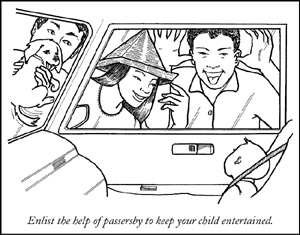
 Eat vegetables yourself.
Eat vegetables yourself.
Be enthusiastic about vegetables. “Beans are awesome!” “Peas rule!” “Rutabagas rock!”
 Talk in euphemisms.
Talk in euphemisms.
Encourage your child by calling the vegetable a “growing food” or “brain food” or “run-fast food” or “beauty food.”
 Require one bite.
Require one bite.
Even if she does not like it, with the “one-bite rule” the child should eventually grow accustomed to the taste, though it may take years.
 Let the child select the vegetable.
Let the child select the vegetable.
Take your child to the grocery store to pick out one vegetable. Invite her into the kitchen to help you prepare it for dinner. She will become emotionally invested in the vegetable and proud of it. She may not only eat the vegetable, she may urge others to do so.
 Sneak vegetables into other dishes.
Sneak vegetables into other dishes.
Camouflage vegetables in stews, lasagna, pot pies, pizza toppings, casseroles, or soups.

 Change presentation.
Change presentation.
Arrange vegetables in a happy face. Use unnaturally colored ketchup (pink, green, blue) to jazz up a pile of vegetables. Make trees with broccoli and asparagus, boats from endive, and a lake out of guacamole.
 Prepare the vegetable in different ways.
Prepare the vegetable in different ways.
If she rejected the steamed broccoli, next time serve it raw with a dip. If the asparagus in cream sauce was not popular, try it with butter and lemon. Use a blender or a juicer to transform the vegetable into a purée or a smoothie.
 Make vegetables the only option.
Make vegetables the only option.
Designate “vegetarian night” and serve nothing but vegetables. Your child will eat them if she is hungry and there is no other food available. When the meal is over, declare the kitchen closed and do not allow snacks or dessert.
 Do not make food into a battle of wills.
Do not make food into a battle of wills.
Be matter-of-fact about whether your child does or does not eat her vegetables. Do not force a vegetable on your child or bribe her to eat. Do not say, “If you eat your brussels sprouts, you can have dessert.” This will interfere with her developing a genuine affection for the vegetable, and reinforce sweets as the truly desirable food.
1 Purchase an inexpensive, analog watch.
2 Place the watch behind a rear tire of your car.
Place the watch before you go to bed at night or away on a trip. If your car is not parked so that it has to be backed up to be moved, place another watch in front of a front tire.
3 Check the watch.
In the morning or on your return, examine the watch. If your child has taken the car while you were away, it will have been crushed, stopping the machinery at the exact time and date.
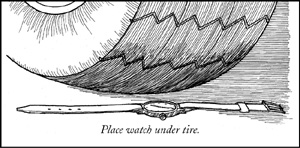
1 After your child goes to his room for bed, remove a hair from your head.
2 Attach the hair to the door of your child’s room.
Use saliva to place one end of the hair on the door-frame and the other on the door itself.
3 Wake up earlier than your child in the morning.
4 Check for the hair.
If your child has left the room during the night, the hair will have become detached or fallen off.
Be Aware
• If your teenager’s room has a window to the garden, water the garden thoroughly each night and rake the dirt smooth. Look for footprints in the morning.
• If you do not have enough hair for the door-hair alarm, if your teen needs to open the door to go to the bathroom, or if a pet might dislodge the hair, grease the front door knob with butter. Check in the morning to see if the knob has been wiped clean so it could be turned and the door opened.
1 Allow yourself time to grieve.
Sadness is a natural reaction to your child’s departure. Permit yourself to cry now and again without shame.
2 Find a temporary replacement for your affection.
To ease the transition, get a pet, or take your child’s photo to a copy center and get a life-sized replica.
3 Wean yourself.
• Rearrange furniture in your entire house, not just in your child’s room. A new look can make you feel like you have entered a new stage of life.
• Remove the most recent photos of your child. Recent photos can be a reminder that he was recently in the house—replace them with older images.
• Establish a “Reminder Jar.” Similar to a “Swearing Jar” into which a parent places money for every swearing infraction, this jar reinforces behavior modification and punishes “remember when” infractions.
4 Convert your child’s room into your own space.
Install a Murphy or sofa bed so that your child will have a place to stay when he comes home for visits, but alter the primary function of the room permanently. Set up a home theater, exercise room, or greenhouse.

5 Return to your pre-child life.
• Read a book.
• Invite your friends over for dinner.
• Fire the maid.
• Enjoy the quiet and calm.
• Watch the television shows you want to watch.
• Find things just where you left them.
• Take a trip.
Be Aware
Keep a list of the things your child did that annoyed, frustrated, and angered you. When you start to recall these things with fondness and a smile, you will have successfully entered the next phase of your life.
 Be sensitive to your child’s needs—for a while.
Be sensitive to your child’s needs—for a while.
Sometimes a child returns home because of a negative life change. Be understanding, and realize that a child moving back home is a difficult situation for all involved. Do not let yourself be exploited, however.
 Charge rent.
Charge rent.
Match market rates—deep discounting will only encourage your child to stay where it’s cheap and easy.
 Assign chores.
Assign chores.
More people means more work, so delegate laundry folding, mowing the lawn, cleaning the porches, washing dishes, raking leaves, and other tasks. Do not offer to pay an allowance. If other family members have also moved in—your son- or daughter-in-law or grandchildren—give them chores as well.
 Motivate change.
Motivate change.
Place the classified advertisements section of the newspaper by your child’s door. Do not change the message on your answering machine. Do not provide him with meals, change his bed linens, or allow him to watch television in the family room.
 Do not alter your new lifestyle.
Do not alter your new lifestyle.
Continue to host your book group, bridge club, and cocktail parties. Continue to use his old room for its new purpose—sewing, exercising, big screen television watching.
 Change the locks.
Change the locks.
Change the alarm code, too.
 Paint the house.
Paint the house.
He might not recognize an unfamiliar color.
 Hide the car.
Hide the car.
Park around the corner.
 Put a different name on the door/mailbox.
Put a different name on the door/mailbox.
 Get a large, unfriendly pet.
Get a large, unfriendly pet.
Any size dog or cat can be effective if he is allergic.
 Move to a smaller place.
Move to a smaller place.
 Disappear.
Disappear.
Go on an extended vacation, rent an RV, or simply move out of town. Turn off your cell phone. Do not leave a forwarding address.

Be Aware
Parenting is forever.